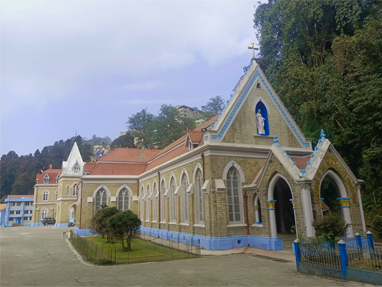
The Loreto Sisters came to India in 1841 at the invitation of the then Archbishop of Calcutta, Dr. Carew. They came to Darjeeling in 1846 to begin their work of “quality education” in the beautiful hills of Darjeeling where the climate was not only health giving but would be convenient for girls who could not be sent to England for their education.
With the assistance of some lay gentlemen the land arrangements were made. Two choir Sisters and a lay Sister with their chaplain came up to start on the 2nd October 1846, “Loreto House Branch Boarding and Day School”. The party consisted of Mother Teresa Mons, Superioress, Mother Mary de Chantel Kelly with two Novices. They were accomplished by Fr. John Mc Girr. Their journey by land and water took two months. Their first residence was “Snowy view” prepared by Mr. Loughnan, the other patrons being Major Samler and Mr. William Moran.
The Sisters began with two students a Miss Ryves and Miss Emma Maron. The nuns moved from Snowy view to the new convent building on 1st May 1847 and the school building was added in 1853 which had particularly large playgrounds.
The nuns continued their work of education under Bishop Carew but in 1848 they were brought under the vicari ate of Patna and Bishop Hartman. The Capuchin Ecclesiastical Superior paid his visit to the Convent in April 1848. This brought Loreto Convent to a new phase where it ceased to be connected with the parent house in Calcutta – this state of thins lasted till 1881. The nuns had by now gained the passionate attachment of their pupils and the parents were satisfied with the admirable management of the school. The girls were getting quality education and were proficient in English, French and had a good taste for Music and Drawing. The numbers went up slowly, in 1852 there were 19 pupils and in 1855 there were 30 pupils. By 1875 there were 107 and by the Golden Jubilee year there were 173 pupils.
The convent also had a small orphanage from mainly soldiers’ children which existed till 1887 when the orphans were transferred to Calcutta i.e. Entally.
The Golden Jubilee of the convent was celebrated in 1896. In 1903 a new concert hall was built and Mrs. Chapman (nee Forbes) contributed towards the building of this hall. In the same year a new novitiate was canonically erected and the novices came from Asansol in 1904 . A new Novitiate building was erected in 1934, the present Loreto Hall. Mother Antionette played a major role in the lives of the soldiers and nurses during World War II as they were housed in the Novitiate building.
To keep in step with the educational developments, the Cambridge examinations were introduced in Darjeeling in 1905 and the first three candidates presented were successful. From the turn of the century, The number of boarders grew and by 1917 there were 211 students out of which 117 were boarders.
By 1926, Mr. Arthur Forbes of Purnea had set up a line of fine buildings as the children began to grow in numbers. The Dining room, Dressing rooms, the Skating Rink and the Lytton Hospital were completed.
Students entered in the exams of the Trinity College of Music, London by 1908. By 1922 the school had a well stocked library and an up-to-date laboratory was set up.
The school celebrated its centenary by 1946- there was a solemn High Mass and Fr. Weaver S.J. preached a sermon in appreciation of all that Loreto had done for the hills in the hundred years just ending. The children staged “Beata Maria” an oratorio in honour of Our Lady in gratitude for a century of grace and guidance.
The school expanded and developed and provided holistic education. The hostel was the home of children for many South-East Asian children and those from Calcutta, Purnea and other places. The children grew in their leadership skills and are now placed in many parts of India and the world in key positions of Civil Administration.
In 1988 the school hostel had to close because we were closing down all the hostels of our schools in India except Entally. Loreto Convent is presently a neighbourhood school with 1600+ pupils from every strata of society with the same benefits of “all round education”.